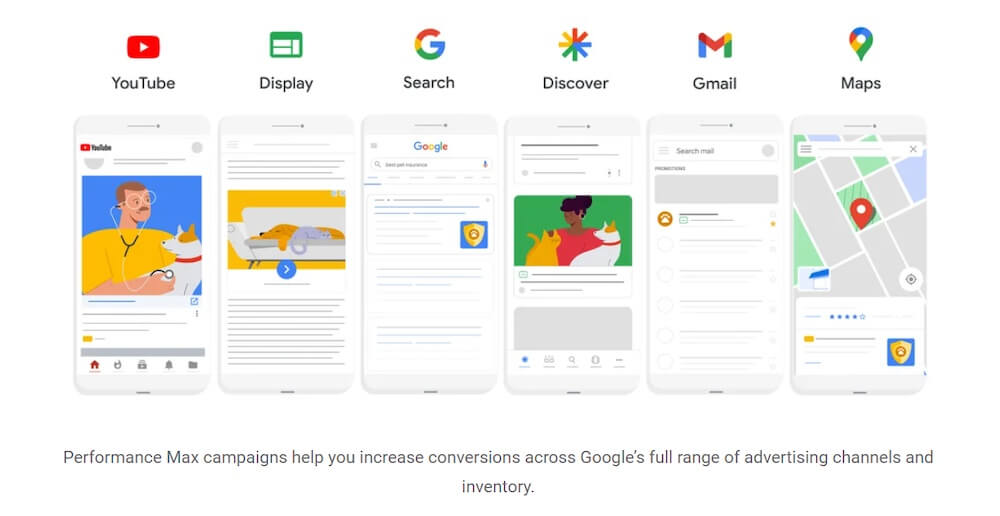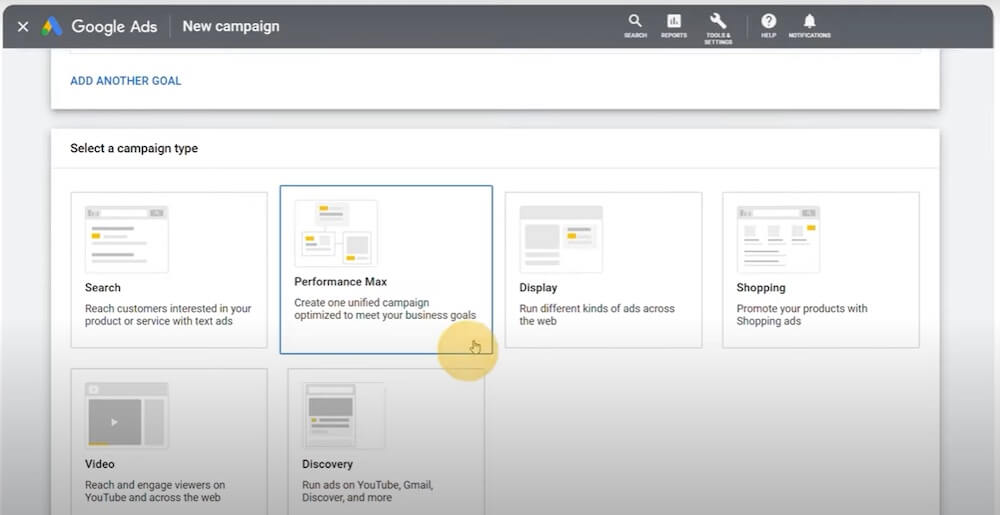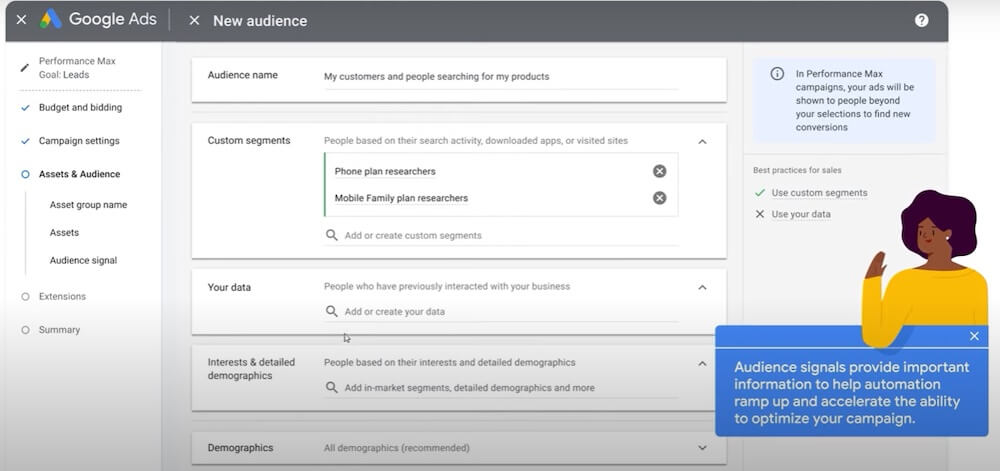Using Google PMax To Maximize Ad Performance
by Joseph Jones • February 4, 2025
If you want to level up your advertising game, you’ve probably heard about Google’s Performance Max (PMax) campaign type, which launched in 2021. But what exactly is PMax, and why should you care? We’ve seen the game-changing impact PMax campaigns can have on our clients, and we’re here to break it all down for you.
In this guide, we’ll explain PMax and how it works and share some practical tips to help you get the most out of your PMax campaigns!
What is Google Performance Max (PMax)?
Google Performance Max (PMax) is an advanced, goal-focused campaign type in Google Ads that puts automation in the driver’s seat. It’s designed for advertisers who want to let Google’s algorithms do the heavy lifting while still delivering top-notch results.
So, what is Google PMax in simple terms? It’s your all-in-one solution that handles ad placements, creative optimization, and bidding—using Google’s powerful machine learning to meet your specific goals.
You set up your campaign, upload your creative assets, and let PMax take care of the rest. Google’s algorithms work behind the scenes to make sure your ads are seen by the right people at the right time across the right platforms.
It’s all about making your life easier while maximizing your campaign’s impact.
Why PMax Matters: The Power Behind the Campaign

What makes PMax so powerful? It’s all about reach and automation. PMax taps into the full range of Google’s networks, putting your ads in front of potential customers across:
- Google Search
- Display Network
- Shopping Ads
- Google Maps
- YouTube
- Gmail
- Discover Feed
The real magic of PMax lies in its ability to optimize everything—from where your ads appear to how much you bid—based on real-time performance data. With Google’s algorithms working around the clock, PMax makes sure your ads hit the sweet spot: the right audience at the right time, on the right platform.
Key Features of Google Performance Max
If you’re diving into PMax, there are a few features you need to know about.
PMax offers several powerful features:
- Audience Signals: Instead of traditional targeting, provide Google with audience signals to guide their algorithms.
- Asset Groups: Group your creative assets by theme or audience, allowing PMax to create and deliver the best ads automatically.
- URL Expansion: Automatically selects the best ad landing pages based on machine learning. You can exclude specific URLs if needed.
- Reporting and Insights: PMax provides detailed reports on what’s driving your campaign’s success, helping you refine your strategy.
So, if you’re ready to maximize your advertising efforts, these PMax features are your new best friends. Embrace them, and watch your campaigns reach new heights without the usual stress and manual labor.
How Do Google PMax Campaigns Work?
Much like Smart Campaigns or Responsive Display Ads, Google PMax campaigns are designed to simplify the ad process. You provide your goals, creative assets, and budget, then let Google’s algorithms take over. Your assets—think images, videos, headlines, etc.—get grouped into “asset groups” from which PMax pulls to create the best-performing ad combinations.
So, what sets PMax apart?
- Automation and Optimization: Unlike traditional campaigns where you manually control everything, PMax automates the whole process. It handles bids, placements, and targeting so you can focus on the big picture.
- Ad Placements: Instead of running separate campaigns for search, display, and video ads, PMax covers all the bases. It automatically picks the best PMax placements to get your ads in front of the right people.
Targeting and Reach: PMax uses advanced machine learning to optimize targeting. You provide audience signals, and Google’s algorithms do the rest, making sure your ads reach the people most likely to convert.
The Main Difference Between PMax and Other Ad Campaign Types

Understanding how PMax compares to other Google Ads campaigns helps one really see its value.
Here’s a quick rundown:
| Aspect | Traditional Campaigns | PMax Campaigns |
| Automation and Optimization | Manual management with some automation options. | It is fully automated from start to finish, simplifying the process. |
| Ad Placements | Ads appear on specific networks like Search or Display. | Ads can appear across all Google networks, with PMax handling placements. |
| Targeting and Reach | Targeting is controlled through keywords and audience segments. | Google’s algorithms optimize targeting based on provided audience signals. |
| Campaign Goals | Goals are set and manually managed by the advertiser. | Goals are central, with PMax using real-time data to achieve them efficiently. |
How to Get the Most Out of Google PMax
If you want to really make PMax work for you, here are some key strategies to keep in mind. These tips will help you leverage Google’s automation while staying aligned with your overall goals.
Set Clear Goals
Start by defining your goals—whether driving more traffic, increasing conversions, or building brand awareness. Clear goals help PMax do its job more effectively.
Prioritize Quality Creative
Even though PMax handles a lot of the heavy lifting, your creative assets still need to shine. Make sure your visuals are eye-catching, and your CTAs are clear to grab your audience’s attention.
Use Strong Audience Signals
Give PMax a helping hand by providing detailed audience signals that match your goals. This helps Google’s algorithms zero in on the people most likely to take action.
Keep an Eye on Performance
Check in regularly to see how your PMax campaigns are doing. Use Google’s insights to tweak and improve your strategy as needed.
Segment Your Audience
Break down your audience by demographics, interests, or behaviors to tailor your messaging. This can boost engagement and make your ads more effective.
Be Smart with Your Budget
Spread your budget wisely across Google’s different networks. Give PMax some time to show what it can do, and adjust your spending based on what’s working best.
Stay Updated
Google is always rolling out new features and updates. Keep yourself in the loop so you can take advantage of the latest tools and stay ahead of the competition.
How to Blend PMax with Your Existing Strategy

Integrating PMax into your current Google Ads strategy can take things up a notch. Here’s how to effectively blend PMax with your existing strategy to maximize results.
Step 1: Start with Traditional Campaigns to Build Awareness
Begin with a traditional Search or Display campaign to generate awareness and drive initial traffic. For example, if you’re launching a new product, you might start with a Search campaign targeting specific keywords related to that product.
This approach helps you attract potential customers who are actively searching for what you offer.
Let’s say you’re promoting a new fitness tracker. You could use a Google Search campaign to target keywords like “best fitness tracker,” “affordable fitness tracker,” or “fitness tracker with heart rate monitor.” As people search for these terms, your ads appear in the search results, driving traffic to your website.
Step 2: Bring in PMax to Maximize Conversions
Once people engage with your initial ads, it’s time to bring in PMax to take things up a notch. Google PMax excels at retargeting and optimizing ad delivery across multiple platforms. It automatically adjusts placements, bids, and creative combinations to ensure your ads show up where and when they’re most likely to convert.
Continuing with the fitness tracker example, after your Search campaign has driven some initial interest, you can use PMax to retarget those visitors. PMax will deliver your ads across various Google platforms—such as YouTube, Gmail, Google Maps, and the Display Network—showing tailored ads to users who have already interacted with your brand.
This cross-channel approach significantly increases the chances of converting these interested prospects into paying customers.
Step 3: Leverage PMax for Cross-Channel Optimization
PMax optimizes your entire campaign across all of Google’s networks. For instance, It can determine that your fitness tracker ads perform exceptionally well on YouTube and Google Discover Feed but may need tweaking on the Display Network.
By automatically reallocating your budget and adjusting your ad placements, PMax ensures that your ads always perform at their best.
Let’s say your PMax campaign identifies that users who watch fitness-related content on YouTube are more likely to click on your ad and make a purchase. PMax will prioritize showing your ads on YouTube, while still maintaining a presence on other platforms, to maximize your overall conversion rate.
Step 4: Monitor and Adjust with PMax’s Reporting and Insights
One of the strengths of Google PMax is its amazing Reporting and Insights. Use this data to monitor how well your blended strategy is performing. If you notice that certain placements or audience signals are driving better results, you can adjust your traditional campaigns to align more closely with these insights.
For example, if PMax shows that your ads are performing exceptionally well among a specific demographic—say, young professionals interested in fitness—you can refine your Search and Display campaigns to target this group more effectively, further boosting your campaign’s efficiency.Blending Google PMax with your current ad strategy can make your campaigns more dynamic and effective. Start with traditional campaigns to build awareness, then let PMax’s automation and cross-channel reach take over to drive conversions. Keep an eye on your results and tweak your strategy using PMax’s insights, and you’ll be set to do great things!
Let’s Get You Set Up With PMax Campaigns
Ready to take your Google Ads strategy to the next level? Let’s get started.
At Disruptive Advertising, we’ve seen how effective Google PMax can be. By following the tips and strategies in this guide, you can tap into the full potential of this cutting-edge campaign type. If you need a hand setting up or fine-tuning your campaigns, we’ve got you covered! As a Google Partner, we have the know-how to help you make the most of your budget and hit your goals.
Let’s make your advertising efforts count.






